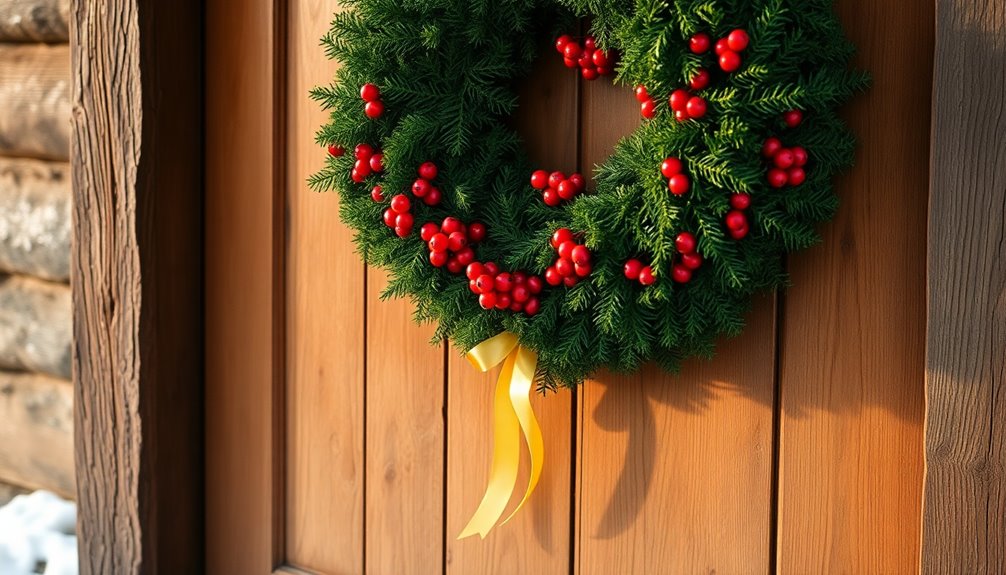You might be surprised to learn that the tradition of hanging a wreath on your door dates back to ancient Greece and Rome, where they symbolized victory and honor. The circular shape represents eternity and unity, while evergreen wreaths adopted by early Christians signify everlasting life. Over time, this tradition evolved into a decorative custom for various celebrations, especially during the holidays. Wreaths now also express community, joy, and creativity, reflecting seasonal changes. You'll find that this enduring practice continues to hold significant meaning, inviting a closer look at its rich history and contemporary uses.
Key Takeaways
- The tradition of placing wreaths on doors originated from ancient Greece and Rome, symbolizing victory and honor.
- Early Christians adopted wreaths as symbols of eternal life and remembrance, particularly using evergreen wreaths.
- Wreaths' circular shape represents eternity and unity, reflecting their cultural significance in various societies.
- Seasonal wreaths, including those for Christmas and Easter, have become integral to festive home decorations.
- Modern trends emphasize DIY wreath crafting, allowing for personalized designs that maintain traditional meanings while adapting to contemporary aesthetics.
Historical Origins of Wreaths
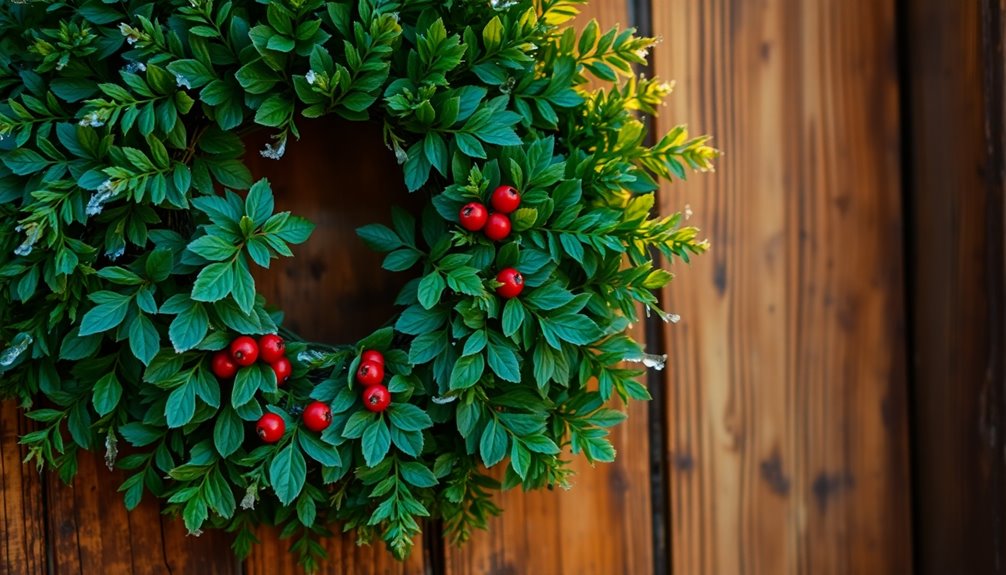
Wreaths have a fascinating history that dates back to ancient times. Originating in ancient Greece and Rome, these circular decorations symbolized victory and honor, often awarded to champions during ceremonies.
The term "wreath" comes from the Old English word "writhen," meaning to twist, reflecting how you craft these beautiful pieces. Their circular shape represents eternity, embodying unity and continuity with no beginning or end.
In early Christian traditions, wreaths took on new meaning, signifying everlasting life and made primarily from evergreen branches, further enhancing themes of renewal and hope.
Today, you see wreaths prominently displayed on doors, especially during Christmas and festive seasons, connecting you to this rich history while adding a warm touch to your celebrations.
Symbolism in Ancient Cultures
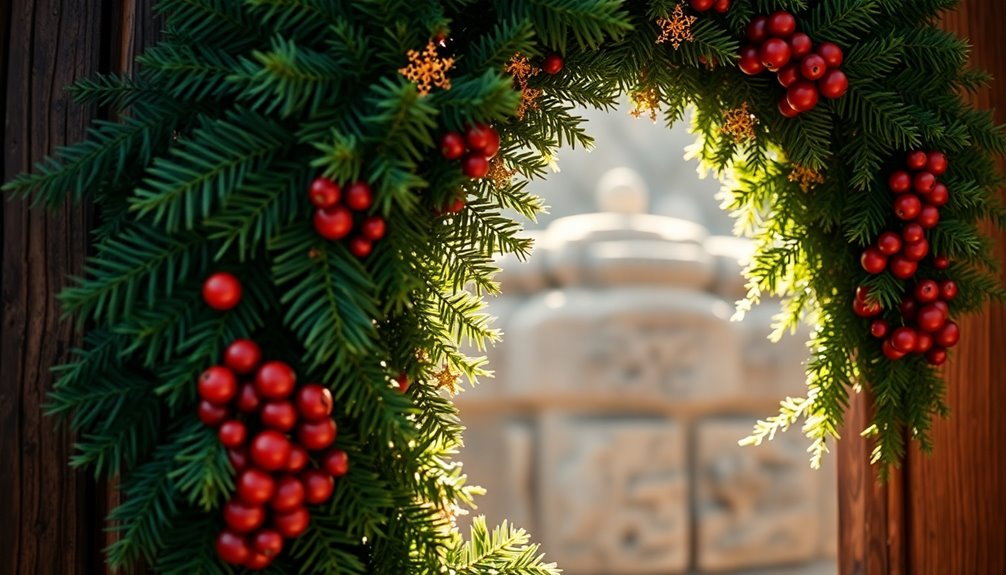
Wreaths have deep roots in ancient Greek and Roman cultures, where they symbolized victory and honor.
In Greece, victors of athletic competitions proudly wore laurel wreaths, while Romans used them to signify high status and divine favor.
The circular shape of these wreaths not only represented triumph but also the eternal cycle of life, intertwining cultural significance with natural themes.
Ancient Greek Traditions
While you might associate wreaths with modern celebrations, their roots run deep in ancient Greek traditions, where they held profound significance.
In ancient Greece, wreaths were crafted from leaves and flowers, symbolizing:
- Victory: Awarded to Olympic champions, laurel wreaths represented achievement.
- Honor: These circular shapes indicated high status within society.
- Eternity: The circular shape symbolizes the continuous cycle of life.
- Religious Significance: Wreaths were used in rituals and offerings to the gods, reinforcing their symbolism.
Through these traditions, wreaths became powerful symbols of triumph and unity.
Their legacy continues today, connecting us to the rich history of honor and celebration in ancient cultures.
Roman Victory Symbols
Ancient traditions of using wreaths as symbols of victory found a prominent place in Roman culture, where they took on even greater significance.
In ancient Rome, laurel wreaths were awarded to victors of athletic competitions, symbolizing honor and achievement. These circular decorations, crafted from leaves and branches, served not just as adornments but as representations of high status.
Generals and emperors donned them during triumphal celebrations, reinforcing their connection to victory and prestige. The circular shape of the wreath signifies eternity and the cycle of life, reflecting the Roman belief in the continuity of spirit and legacy through triumph.
This rich tradition influenced later practices, embedding wreaths as enduring symbols of honor in various celebrations today.
Wreaths in Christianity
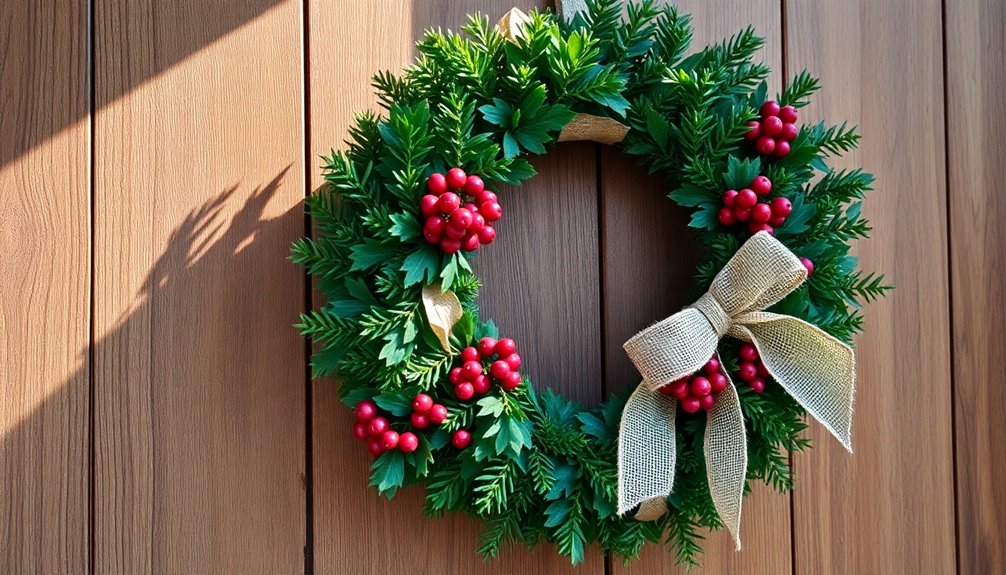
As the Advent season approaches, many Christians embrace the tradition of decorating with wreaths, which symbolize hope and anticipation for the birth of Jesus Christ.
Wreaths are used primarily as an Advent wreath, highlighting significant themes throughout the season. The circular shape represents eternity and God's unending love, while the evergreens signify eternal life.
Here are some key components of the Advent wreath:
- Four Candles: Each represents a week of Advent and a different theme.
- Center Candle: Lit on Christmas Eve, symbolizing Christ as the light of the world.
- Evergreen Materials: Reflect resilience and renewal in faith.
- Home Decorations: An invitation for the Christmas spirit to enter your home.
The Evergreen Tradition
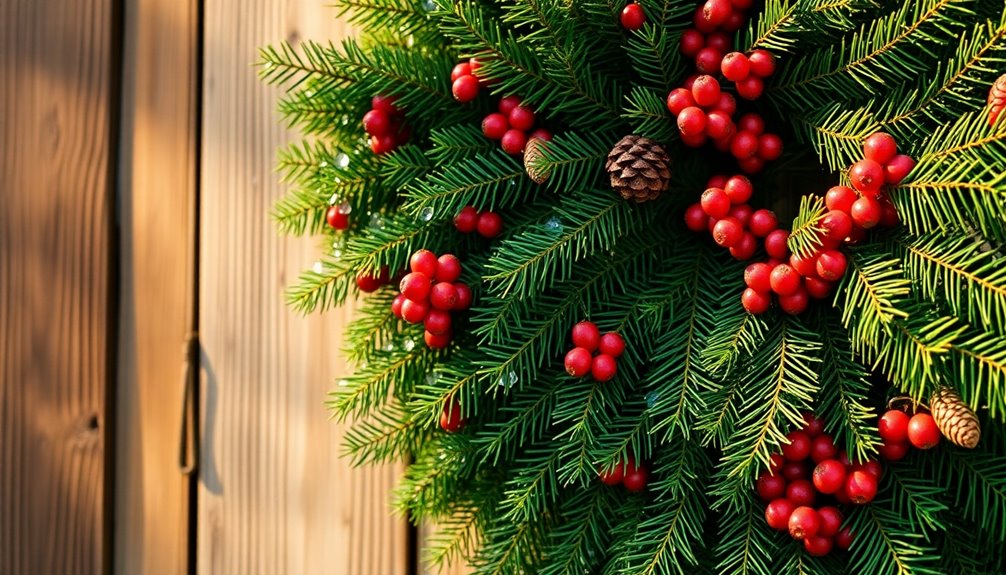
Evergreen wreaths have become a beloved symbol of the holiday season, connecting us to both ancient traditions and modern celebrations.
Originating in ancient Rome, these wreaths symbolized victory and honored individuals during festivities. Made from durable foliage like pine and holly, evergreen wreaths represent eternal life and resilience through winter, making them perfect for seasonal decor.
In early Christianity, they took on deeper meaning, symbolizing God's everlasting love and the cycle of life. The circular shape of these wreaths signifies continuity and unity, reinforcing the themes of hope and renewal associated with evergreen materials.
Today, you'll find them adorning doors everywhere, reflecting both their aesthetic appeal and rich cultural significance during the holidays.
Seasonal Wreath Variations
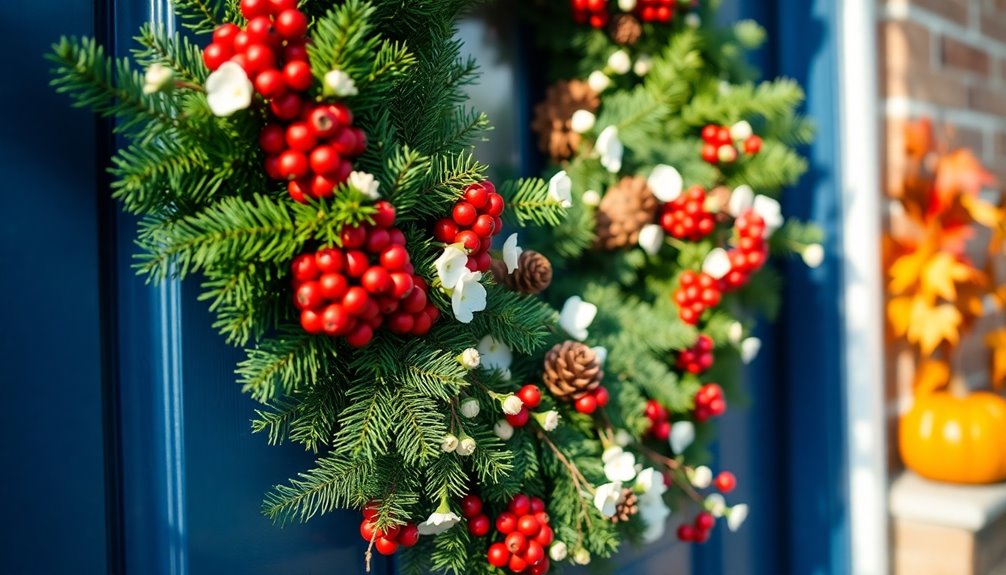
When it comes to seasonal wreath variations, you can truly express the mood of each time of year.
Spring floral wreaths burst with color and life, while holiday evergreen designs bring warmth and festivity into your home.
Each wreath not only enhances your space but also celebrates the unique spirit of the season.
Spring Floral Wreaths
Spring floral wreaths bring a burst of color and life to your doorstep, celebrating the season of renewal.
These vibrant decorations welcome guests and reflect the joy of spring. When crafting your spring wreaths, consider these popular elements for a fresh look:
- Tulips: Bright and cheerful, perfect for any home decor.
- Daffodils: Symbolizing new beginnings, they add a touch of sunshine.
- Lilacs: Their lovely fragrance enhances your entrance.
- Red berries: These accents provide a beautiful contrast and visual interest.
Wreath making has evolved, incorporating dried flowers and ribbons, allowing you to personalize your design. Additionally, consider using natural materials to enhance the aesthetic appeal of your wreath.
Whether you choose fresh greenery or evergreen branches, your floral wreaths will capture the spirit of the season beautifully.
Holiday Evergreen Designs
As the holidays approach, many people embrace the tradition of creating holiday evergreen wreaths that not only beautify their homes but also symbolize the enduring spirit of the season.
These wreaths, made from durable materials like pine, fir, and holly, represent everlasting life, making them a perfect choice during winter months. You can hang a greenery wreath on the front of your door, adding a touch of nature and warmth.
Advent wreaths, adorned with candles, enhance the festive atmosphere while symbolizing hope and anticipation.
Modern designs often feature seasonal embellishments like red berries and pinecones, allowing you to personalize your holiday evergreen wreaths to reflect your unique style and seasonal themes.
Wreaths for Celebration and Mourning

Wreaths hold a unique place in human tradition, serving dual purposes that bridge the gap between celebration and mourning. These circular symbols represent eternity and the cycle of life, making them fitting for both joyous and somber occasions.
Here are a few ways wreaths are used:
- Celebration: In ancient Rome, holly wreaths were exchanged during Saturnalia, symbolizing good fortune.
- Mourning: Evergreen wreaths adorn graves, honoring the deceased and signifying remembrance.
- Tribute: Wreaths at military memorials serve as poignant reminders of sacrifice.
- Sentiment: Specific flowers in wreaths communicate feelings of grief and hope during funerals.
Whether celebrating life or mourning loss, wreaths embody deep cultural significance, connecting us through shared emotions and traditions.
Modern Wreath-Making Trends
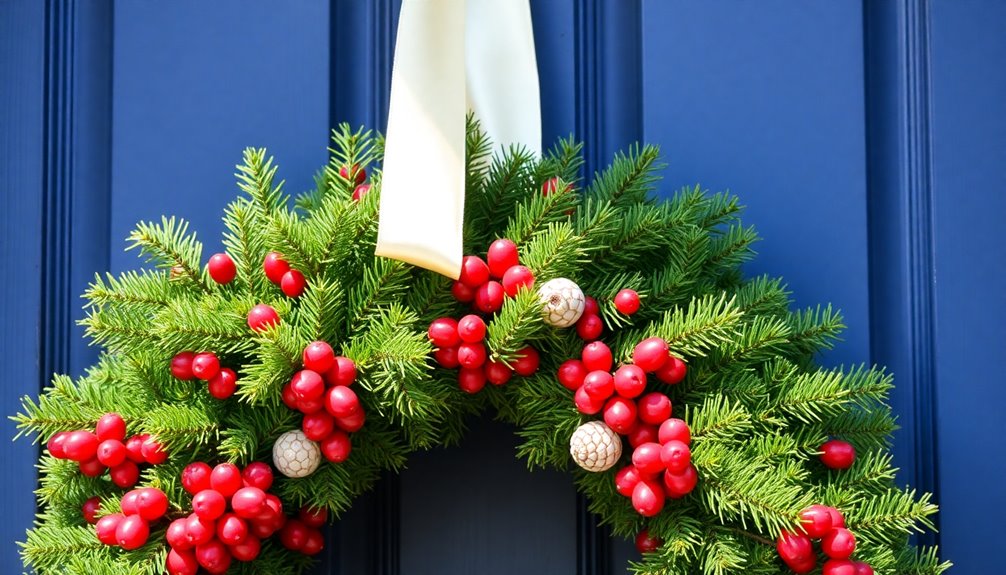
While wreaths have long been symbols of celebration and remembrance, their modern applications have evolved considerably.
Today, modern wreath-making emphasizes sustainable materials, incorporating natural and upcycled elements to support environmental consciousness in home decor. DIY wreath-making has surged in popularity, allowing you to craft personalized designs that showcase your unique style and seasonal themes.
Social media platforms greatly influence wreath designs and trends, providing a wealth of innovative ideas that inspire you to create or buy decorative wreaths. With a wide variety of styles—from minimalist eucalyptus designs to elaborate floral arrangements—there's something for everyone.
The wreath market is projected to reach $1.2 billion by 2030, driven by home decor trends and the growing demand for seasonal decorations.
DIY Wreath Crafting
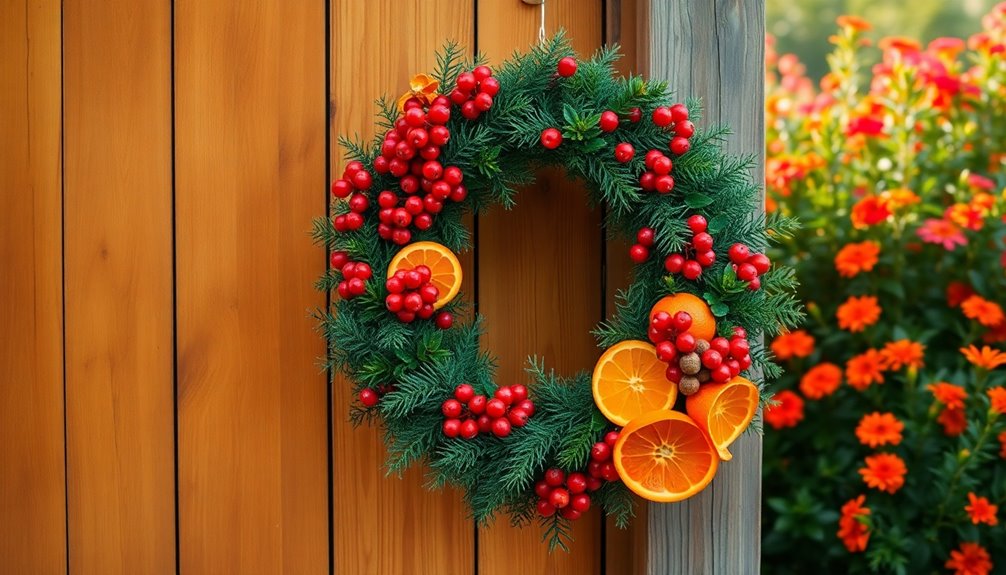
Crafting DIY wreaths lets you express your creativity and personal style, making it an enjoyable activity for any occasion.
Whether you're a beginner or an experienced crafter, the world of DIY wreath crafting is accessible and fun. Here are some ways to get started:
- Choose Sustainable Materials: Use foraged foliage, upcycled items, or biodegradable options.
- Explore Seasonal Themes: Design wreaths for spring blooms, autumn leaves, or festive winter motifs.
- Join Workshops: Find local classes to learn new techniques and meet fellow crafters.
- Utilize Online Tutorials: Discover endless inspiration on social media platforms to elevate your designs.
With countless resources available, you'll create stunning wreaths that reflect your unique style and values.
Wreaths in Cultural Celebrations
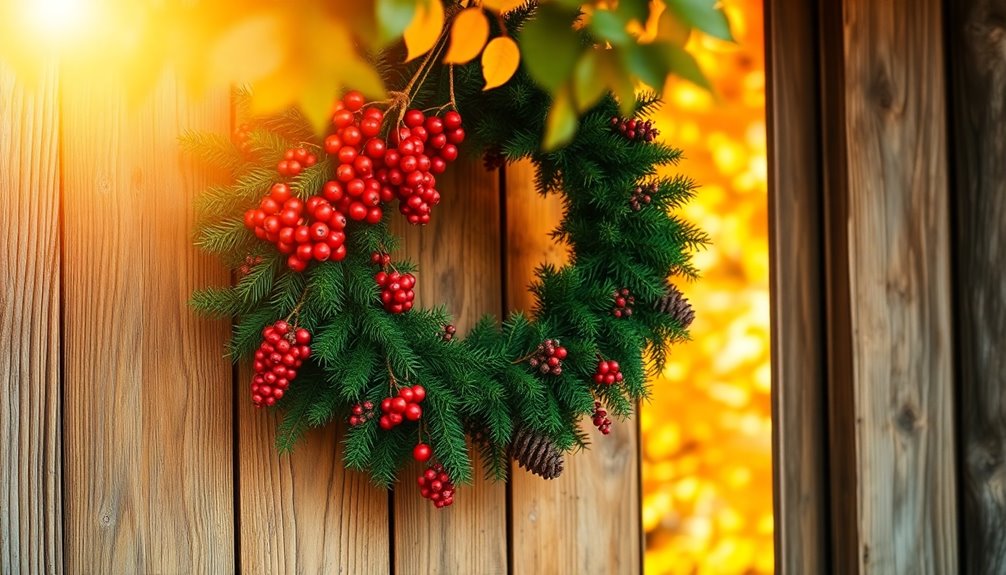
Wreaths carry deep historical significance, reflecting their journey from ancient Roman victory symbols to modern-day festive decorations.
As you explore various cultural celebrations, you'll notice how these circular creations play a role in marking seasons and traditions, from Christmas to May Day.
Their shape embodies unity and continuity, making wreaths a timeless element in festivities worldwide.
Historical Significance of Wreaths
Throughout history, the circular form of wreaths has held deep cultural significance, symbolizing eternity and unity.
You'll find that these ancient customs have evolved over time, representing various aspects of life and celebrations. Here are some key historical significances of wreaths:
- In ancient Greece and Rome, wreaths symbolized victory during public celebrations.
- Early Christians adopted wreaths as symbols of eternal life, using evergreen wreaths for remembrance of the deceased.
- May Day wreaths celebrated fertility and the arrival of spring.
- Advent wreaths marked preparation for the Christmas season.
Today, wreaths continue to play an essential role in cultural traditions, serving as joyful symbols of hospitality and community during festive celebrations around the world.
Seasonal Celebrations and Traditions
As you embrace the changing seasons, wreaths become a vibrant expression of celebration and cultural identity. These circular decorations, symbolizing eternal life, have deep roots in various traditions.
In early Christianity, wreaths adorned doors during Advent, inviting the Christmas spirit into homes. Today, they’re integral to seasonal celebrations around the world, from Christmas to Easter and Midsummer. These festive decorations not only symbolize the joy of the season but also set the mood for gatherings with family and friends. As people look for ways to enhance their holiday spirit, creative themes like reindeerthemed dining room ideas have gained popularity, turning ordinary spaces into winter wonderlands. From table settings adorned with whimsical reindeer motifs to centerpieces that capture the essence of the holidays, these imaginative touches bring a unique charm to seasonal celebrations.
Each wreath you display reflects personal and cultural aesthetics, often crafted with seasonal foliage that mirrors the time of year. The circular shape signifies eternity and continuity, making wreaths perfect for marking the cyclical nature of life.
With every wreath you hang, you're participating in a rich tapestry of traditions that unite communities and celebrate the beauty of each season.
The Future of Wreath Traditions
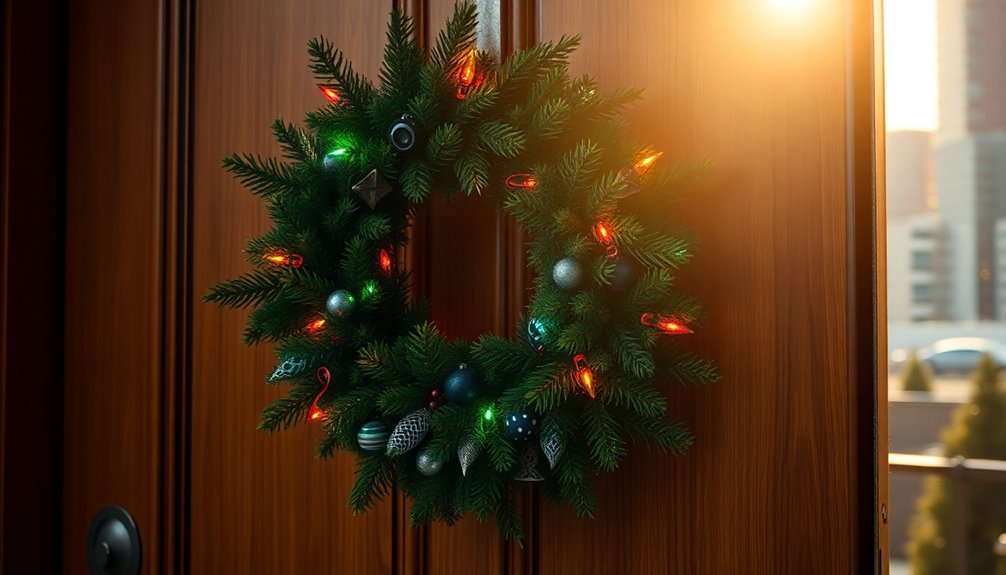
While wreaths have traditionally adorned doors during the holiday season, their role in home decor is evolving. Wreaths became popular year-round decor items, with a projected market value of $1.2 billion by 2030.
Here's how you can embrace the future of wreath traditions:
- Sustainable Materials: Opt for eco-friendly and upcycled materials to create beautiful wreaths.
- Personalized Wreath Designs: Express your style with custom crafting options that reflect your personality.
- Technology: Use advancements like 3D printing and smart LED lights to enhance your designs.
- Social Media Influence: Get inspired by sharing and discovering creative wreath ideas online.
As customs in Europe evolve, you can make wreaths that celebrate unique, modern aesthetics.
Frequently Asked Questions
What Is the Origin of Wreaths on Doors?
The origin of wreaths on doors traces back to ancient traditions where they symbolized victory and honor.
As you hang a wreath, think about its evolution into a sign of hospitality and celebration. The circular shape represents eternity, inviting warmth into your home.
In early Christianity, wreaths became tied to the Advent season, reflecting hope and unity.
What Does a Wreath on Your Door Symbolize?
When you hang a wreath on your door, you're weaving a tapestry of warmth and welcome. It symbolizes hospitality, inviting friends and family into your space.
The evergreen elements speak of eternal life, reminding you of hope and resilience. As the circular shape represents unity, it echoes life's continuity.
Each seasonal adornment connects you to nature's rhythm, reflecting the beauty of the changing seasons and the joy of community in your life.
What Does Placed a Wreath Upon His Door Mean?
When you place a wreath upon your door, you're sending a warm invitation to guests, symbolizing hospitality and welcome. This gesture often reflects your festive spirit, signaling that your home is ready for celebration.
The circular shape represents eternity, adding a deeper meaning of unity and everlasting life. Whether for a holiday or a special occasion, a wreath on your door connects you with tradition and community, enhancing the atmosphere of joy and togetherness.
Are Wreaths Associated With Christianity?
Wreaths are practically the ultimate symbol of Christianity! They're rich with meaning, representing eternal life and God's love.
The circular shape reflects unity, while evergreen materials signify resilience and immortality, especially during winter.
You'll often find wreaths adorned with red berries, which symbolize Jesus' blood, tying back to His sacrifice.
When you hang a wreath during the holidays, you're not just decorating; you're inviting spirituality and faith into your home.
Conclusion
As you hang a wreath on your door, you're not just decorating; you're connecting with centuries of history. From the ancient Greeks who celebrated victory to modern families embracing seasonal cheer, wreaths embody a rich tapestry of meaning. While some see them as mere ornaments, others recognize their significance in symbolizing life and renewal. In this blend of past and present, your wreath becomes a personal statement, bridging tradition with your unique style and spirit.
